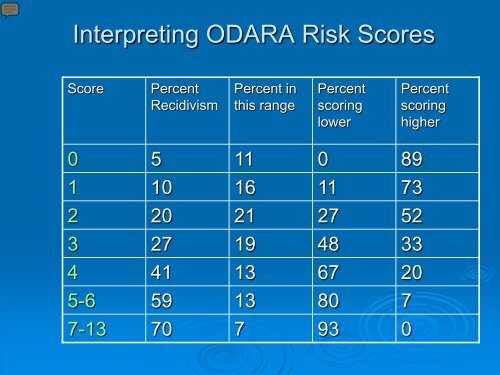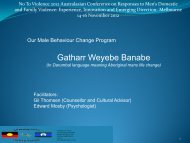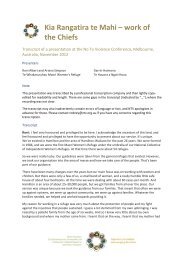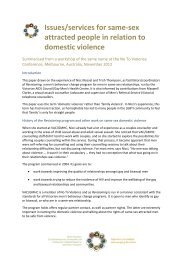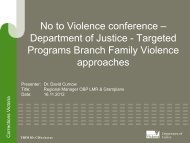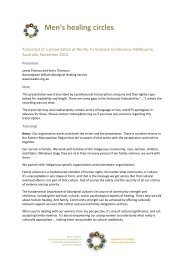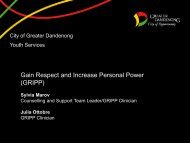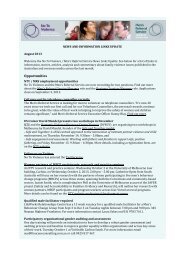Interpreting ODARA Risk Scores
Read the workshop document â part three - No To Violence
Read the workshop document â part three - No To Violence
Create successful ePaper yourself
Turn your PDF publications into a flip-book with our unique Google optimized e-Paper software.
<strong>Interpreting</strong> <strong>ODARA</strong> <strong>Risk</strong> <strong>Scores</strong><br />
Score<br />
Percent<br />
Recidivism<br />
Percent in<br />
this range<br />
Percent<br />
scoring<br />
lower<br />
Percent<br />
scoring<br />
higher<br />
0 5 11 0 89<br />
1 10 16 11 73<br />
2 20 21 27 52<br />
3 27 19 48 33<br />
4 41 13 67 20<br />
5-6 59 13 80 7<br />
7-13 70 7 93 0
Using <strong>ODARA</strong><br />
POLICE<br />
‣ Inform decisions on attendance at Family Violence<br />
occurrence<br />
‣ Police bail – nature and type of conditions<br />
‣ Support opposition to bail applications<br />
‣ Relevant supporting information for all offender<br />
management decisions<br />
‣ Inform victim crisis referral, Emergency transportation<br />
‣ Crown brief<br />
‣ Inform tactical decisions around prioritizing offenders<br />
/ victims for intervention and preventative activities
Using <strong>ODARA</strong> – Courts/Probation<br />
Bail<br />
‣ Higher scoring offenders represent more substantial risk<br />
‣ Custody, Bail conditions<br />
‣ Victim services liaison<br />
Sentencing<br />
‣ Incarceration, Duration<br />
‣ Probation conditions<br />
Probation and Parole<br />
‣ Higher risk offenders: more supervision<br />
‣ Conditions of release<br />
‣ Supervision frequency, Intensity<br />
‣ Referral to treatment programs
Uses of <strong>ODARA</strong><br />
Identification of potential risk to Victim<br />
(and children in relationship)<br />
‣ Assists in explaining to victims, and their understanding<br />
of, potential risk<br />
‣ Improve victim engagement with service providers<br />
‣ Enable appropriate safety planning commensurate to<br />
identified risk for victim<br />
‣ Information to victims on uses of <strong>ODARA</strong> by the Criminal<br />
Justice System<br />
Offender Treatment Decisions<br />
‣ Resource allocation<br />
‣ Attrition<br />
‣ Victim contact<br />
A common metric for all sectors working together to<br />
prevent intimate partner violence
Certification and Registration<br />
‣ <strong>ODARA</strong> is an internationally validated risk<br />
assessment tool, it will be tested and validated in NZ<br />
by NZ Police<br />
‣ To maintain integrity and predictive validity of<br />
<strong>ODARA</strong> scores, NZ Police must comply with<br />
training, certification and registration requirements.<br />
‣ Frontline staff will collect <strong>ODARA</strong> information –<br />
scores will be validated by specialists who are<br />
trained users.<br />
‣ All training of users will be provided by the FV Unit<br />
and delivered by a registered <strong>ODARA</strong> trainer<br />
‣ All staff who successfully complete the <strong>ODARA</strong> user<br />
training will be certified and internationally<br />
registered.
Collection of <strong>Risk</strong> Information<br />
(IPV - <strong>ODARA</strong> not applicable)<br />
Once <strong>ODARA</strong> was chosen we needed to look specifically at<br />
how to manage risk to occurrences where <strong>ODARA</strong> did not<br />
apply…<br />
To score the <strong>ODARA</strong>, (the index assault) must be met.<br />
Definition - index assault:<br />
• the most recent incident known to police in which<br />
violence occurred between intimate partners …<br />
• ‘Violence’ = physical and /or sexual assault and/ or a<br />
credible threat of harm or death with a weapon in hand,<br />
in the presence of the victim<br />
‣ <strong>Risk</strong> information was required for IPV attendances where<br />
<strong>ODARA</strong> does not apply (the orange wedge)
Collection of <strong>Risk</strong> Information<br />
(IPV - <strong>ODARA</strong> not applicable)<br />
‣ Confident that <strong>ODARA</strong> will help prioritize cases and<br />
assess risk where physical violence or imminent threat<br />
of it applies<br />
‣ Actuarial tools not generally developed to assess risk<br />
at the ‘lower level’, usually designed to predict an<br />
event<br />
‣ But still need to collect risk information about non<br />
<strong>ODARA</strong> IPV cases to help inform decision making<br />
(Victim safety and offender management)<br />
‣ IPV non <strong>ODARA</strong> cases are approximately 56% of<br />
attendances<br />
‣ Used research and prior recent work by Ontario<br />
Provincial Police to develop NZ Police’s own<br />
structured professional judgment tool – a list of<br />
variables known to predict risk of harm in IPV cases =<br />
Intimate Partner Vulnerability Factors
Collection of <strong>Risk</strong> Information<br />
(IPV - <strong>ODARA</strong> not applicable)<br />
‣ Acute and dynamic factors a primary focus to ensure<br />
lower level attendance by Police is not something<br />
more serious.<br />
‣ This information also forms part of the history where<br />
there are both <strong>ODARA</strong> and Non <strong>ODARA</strong> attendances<br />
by Police<br />
‣ As with the Child <strong>Risk</strong> Factors, items are not scored<br />
(not a validated tool) but are listed as present, not<br />
present or unknown.<br />
‣ The number of factors and combination of factors are<br />
both important. It is the professional judgment and<br />
experience of FV specialists in interpreting the<br />
information that is important<br />
‣ Commentary and summary on front page FV reports.
<strong>Risk</strong> Information for Non <strong>ODARA</strong> IPV<br />
Intimate Partner Vulnerability Factors<br />
‣ Recent change in relationship status<br />
‣ Offender wanting to renew the relationship<br />
‣ Officer identifies / partner discloses psychological violence<br />
‣ Chronic violence in the relationship<br />
‣ Violence - increasing severity/frequency<br />
‣ Victim believes offender could kill or injure her<br />
‣ Offender has strangled the victim<br />
‣ Offender has threatened/attempted suicide<br />
‣ Offender has threatened to kill the victim or others<br />
‣ Offender has a history of violence against others<br />
‣ Offender has stalked the victim<br />
‣ Offender has exhibited sexual jealousy<br />
‣ Offender is recently unemployed / under financial pressure<br />
‣ Offender has history of drug / alcohol use<br />
‣ Offender has diagnosed mental illness<br />
‣ Offender has diagnosed personality disorder
<strong>Risk</strong> Management – Collection of<br />
<strong>Risk</strong> Information - Children<br />
Once collection of risk information for IPV response<br />
(<strong>ODARA</strong> and IPVF) was determined we needed to look<br />
specifically at how to manage remaining risk<br />
‣ 30% not IPV; (The ‘blue wedge’ – <strong>ODARA</strong> / IPVF not<br />
relevant)<br />
- 20% child related FV<br />
- 10% ‘Other’ FV – No RA tool applicable<br />
Addressing <strong>Risk</strong> to Children<br />
‣ It was important to consider how Police could specifically<br />
address risks to children when attending FV incidents.<br />
‣ Work was commissioned to look at whether there was<br />
identifiable and recognized risks to children living in families<br />
engaged in FV.
<strong>Risk</strong> Management:<br />
Collection of <strong>Risk</strong> Information – CHILDREN<br />
‣ As part of the review Police specifically considered how<br />
we could address risks to children when attending FV<br />
incidents.<br />
‣ Previous response was to apply the assessed<br />
relationship risk to inform decisions about the child/ren.<br />
‣ Research confirmed - high inter-relationship between IPV<br />
and the incidence of child abuse and neglect = 70%<br />
correlation.<br />
‣ Automatic screening in some countries (e.g. UK).<br />
‣ Concern with a very high percentage of child FV deaths in<br />
immediate and wider family context in New Zealand (child<br />
deaths are approximately 33% of all FV deaths in NZ).
<strong>Risk</strong> Management:<br />
Collection of <strong>Risk</strong> Information – CHILDREN<br />
‣ The Child <strong>Risk</strong> Factor Form (CRF) was developed by using<br />
clearly identified risk factors derived from research<br />
‣ These factors are clearly distinct from those related to IPV<br />
(relationship risk)<br />
‣ The CRF went through a consultation process with key partner<br />
agencies including CYF. Critical factors have been identified to<br />
guide referral to CYFs and the usefulness of the information is<br />
being evaluated<br />
‣ Balance was required to ensure CRF would not overburden<br />
staff or be outside ‘Police role’<br />
‣ CRF is not a risk assessment tool, but a list of variables to<br />
inform professional judgment in making decisions<br />
‣ The CRF is also relevant to Vulnerable children work being led<br />
by MSD.
Child <strong>Risk</strong> Factors<br />
‣ In the new FV response model, CRF’s will be<br />
completed for all children involved in Family Violence<br />
occurrences attended by NZP<br />
‣ Only one CRF is completed for all children present that<br />
are 16 years of age or younger<br />
‣ The CRF records the presence or not of known risk<br />
factors grouped into categories – aggressor, family and<br />
child specific<br />
‣ Police will collect this information and share it with<br />
partner agencies<br />
‣ We are not usurping the role of CYF to determine and<br />
be responsible for identifying and managing at risk<br />
children, but we will be able to assist by providing better<br />
quality information
‣ CHILD<br />
• Child unborn<br />
Child <strong>Risk</strong> Factors<br />
• Child/ren under 5 years of age<br />
• Child/ren with physical and / or intellectual disability<br />
• Previous or current evidence of child abuse / neglect<br />
• Necessaries not appropriately provided for (lack of<br />
bedding, nappies, food, heating etc)<br />
‣ AGGRESSOR / PROTECTIVE PARENT<br />
• History of alcohol and / or drug use<br />
• Diagnosed mental illness<br />
• Criminal history in the last 5 years<br />
• Evidence of stalking in the relationship (agg)<br />
• Extremely controlling behaviour in the relationship (agg)
Child <strong>Risk</strong> Factors (cont)<br />
‣ FAMILY<br />
• Police history of family violence<br />
• Current Protection order / Family Court Order or<br />
PSO<br />
• Recent stressors (grief, unemployment…)<br />
• Non-biological parents<br />
• Mother under 25 years of age<br />
• Recent change in relationship status<br />
• Physical and or sexual assault of parent /<br />
caregiver at current occurrence
How is the Model Working?<br />
‣ Situational Response Model has been in place<br />
since 1 July 2012<br />
‣ Some difficulty in extracting data early on<br />
‣ Reporting now indicates good national<br />
consistency<br />
‣ Picture different from the Canadian experience<br />
‣ Independent analysis and evaluation of quality<br />
/ accuracy of data to standard required to<br />
enable data to be introduced to criminal justice<br />
sector
How is the Model Working?<br />
National Data Overview 1.7.12– 30.9.12<br />
(Provisional data only)<br />
• 55.3% (11 264) of occurrences were intimate<br />
partner violence (IPV)<br />
• 44.7% (9100) of occurrences were intrafamily<br />
violence (IFV)<br />
• children were present at 59.4% of<br />
occurrences<br />
• <strong>ODARA</strong> was applied in 15.7% of occurrences<br />
• Intra-family violence (IFV) Index offences<br />
(<strong>ODARA</strong> equivalent) were 12% of all<br />
occurrences
Breakdown of FV Occurrences - National<br />
Occurrences created 01 July to 30 Sep 2012<br />
Inter-Family - Index<br />
Offence, 2445,<br />
12.0%<br />
(CVF, 1302, 6.4%)<br />
Inter-Family, 6655,<br />
32.7%<br />
(CVF, 3866, 19.0%)<br />
IPVF, 8065, 39.6%<br />
(CVF, 5008, 24.6%)<br />
<strong>ODARA</strong>, 3199, 15.7%<br />
(CVF, 1908, 9.4%)
Canadian Research Results<br />
% Recidivism<br />
80<br />
60<br />
40<br />
20<br />
50<br />
40<br />
30<br />
20<br />
10<br />
% in <strong>ODARA</strong> Category<br />
0<br />
0 1 2 3 4 5, 6 7 +<br />
0<br />
NZ Results<br />
% Recidivism<br />
80<br />
60<br />
40<br />
20<br />
50<br />
40<br />
30<br />
20<br />
10<br />
% in <strong>ODARA</strong> Category<br />
0<br />
0 1 2 3 4 5, 6 7 +<br />
0
National <strong>ODARA</strong> Validated <strong>Scores</strong> (Jul-Sep 2012)<br />
80<br />
50<br />
% Recidivism<br />
60<br />
40<br />
20<br />
40<br />
30<br />
20<br />
10<br />
% in <strong>ODARA</strong> Category<br />
0<br />
0 1 2 3 4 5 6 7 8 9 10 11 +<br />
0
How does the model inform<br />
tactics?<br />
Identify, Plan, Implement, Evaluate (IPIE)<br />
‣ Early intervention versus high risk prioritization<br />
(balance)<br />
‣ Prevention continuum triangle<br />
‣ Tendency of emergency response to focus on crisis /<br />
resolve cycle<br />
‣ Ring fence resource on specified or universal<br />
approaches –<br />
‣ Start by understanding / identifying target<br />
populations…
How does the model inform tactics?<br />
‣ Use the three sectors:<br />
• IPV (<strong>ODARA</strong> and Non index offence occurrences) –<br />
• Intra- Family Violence (Index and non index offence<br />
occurrences); and<br />
• Vulnerable children<br />
‣ Split resources to high and early intervention initiatives<br />
‣ Area profile, number of targets based on % breakdown<br />
of each group and objectives for each group<br />
‣ Vulnerability factors and opportunities =<br />
• <strong>Risk</strong> assessment / risk information<br />
• CRF critical factors and other CRF indicators<br />
• Repeats<br />
• Family Violence and Criminal history<br />
• Individual variables: mental health, addiction, gang assn etc
Identify,<br />
Prioritise & Plan /<br />
Implement /<br />
Evaluate<br />
(IPIE)<br />
1.Identify<br />
- Key agency and<br />
internal<br />
partnerships<br />
- Intervention<br />
options (Police /<br />
Collaborative)<br />
- Area Data (IPV,<br />
IFV, Children) %<br />
- Targets<br />
(offenders, victims,<br />
vulnerable<br />
children)<br />
-Target both high<br />
risk and early<br />
intervention<br />
3. Implement<br />
plans<br />
- In order of priority<br />
- with clear<br />
objectives<br />
- report on action<br />
taken<br />
2.Prioritise/<br />
Plan<br />
- Duration of plan<br />
(weekly, monthly)<br />
- Determine<br />
numbers of target<br />
for each focus<br />
group (IPV, IFV,<br />
Children)<br />
- Place targets in<br />
order of priority<br />
- Develop plans in<br />
partnerships with<br />
key agencies and<br />
internal groups as<br />
appropriate.-<br />
4.Evaluate<br />
- Further reports of<br />
FV?<br />
_ Interventions /<br />
completed or in<br />
place<br />
- Feedback from<br />
partner agencies/<br />
internal groups and<br />
victims
FAMILY VIOLENCE SITUATIONAL RESPONSE TACTICAL SUMMARY<br />
(NB model assumes a collaborative approach)<br />
15.7<br />
%<br />
High <strong>Risk</strong><br />
Interventions<br />
Early<br />
Intervention<br />
Strategies<br />
39.6<br />
%<br />
Identifying,<br />
Assessing<br />
and managing<br />
child harm<br />
and lethality risk<br />
Intimate<br />
Partner<br />
Violence<br />
Identifying,<br />
assessing and<br />
managing<br />
relationship risk<br />
Identifying,<br />
assessing and<br />
managing inter-family<br />
violence dynamics<br />
Vulnerable<br />
Children<br />
Inter-<br />
Family<br />
Violence<br />
High <strong>Risk</strong><br />
Interventions<br />
Early<br />
Intervention<br />
strategies<br />
High <strong>Risk</strong><br />
Interventions<br />
Early<br />
Intervention<br />
Strategies<br />
59.5<br />
%<br />
12%<br />
32.7<br />
%
Group Exercise 2<br />
What does ‘a good’ FV response<br />
model look like?<br />
‣ identify what your group thinks are the two<br />
key strengths of the model<br />
‣ identify one area where your group thinks<br />
the model could be improved; and<br />
‣ one possible solution for enhancing the<br />
current model<br />
(15 minutes)
Key Response Lessons<br />
‣ IPV as a distinct group – carve it up<br />
‣ Blanket responses ineffective<br />
‣ Relationship risk versus child harm and<br />
lethality risk<br />
‣ Maintain focus on IFV as well as IPV<br />
‣ <strong>Risk</strong> information to support risk<br />
assessment tools<br />
‣ Prevention versus crisis response – tactics
QUESTIONS<br />
‣ Questions welcome if we have time left!!<br />
• Building the model<br />
• About the model – or its parts<br />
• Tactics<br />
• Evaluation…etc<br />
‣ Not withstanding I can also be contacted<br />
by email – brigitte.nimmo@police.govt.nz<br />
‣ Thanks for your contributions.


